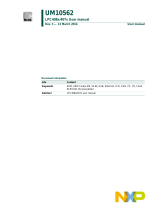
PN7462 family HW user manual
All information provided in this document is subject to legal disclaimers.
© NXP B.V. 2018. All rights reserved.
User manual
COMPANY PUBLIC
Rev. 1.4 — 14 May 2018
314514
1.2 Features and benefits
1.2.1 Integrated contact interface front-end
This chapter applies to the products with contact interface only.
• Class A, B, and C cards can work on 1.8 V, 3 V, and 5 V supply
• Specific ISO UART, variable baud rate through frequency or division ratio
programming, error management at character level for T = 0, and extra guard
time register
• DC-to-DC converter for class A support starting at 3 V, and class B support
starting at 2.7 V
• Thermal and short-circuit protection on contact cards
• Automatic activation and deactivation sequence, initiated by software or by
hardware in case of short-circuit, card removal, overheating, and VDD or VDD
drop-out
• Enhanced ESD protection (> 12 kV)
• ISO/IEC 7816 compliant
• EMVCo 4.3 compliant
• Clock generation up to 13.56 MHz
• Synchronous card support
• Possibility to extend the number of contact interfaces, with the addition of slot
extenders such as TDA8026
1.2.2 Integrated ISO/IEC 7816-3&4 UART interface
This chapter applies to the products with Integrated ISO/IEC 7816 UART interface
only.
The PN7462 family offers the possibility to extend the number of contact interfaces
available. It uses an I/O auxiliary interface to connect a slot extension (TDA8035 - 1 slot,
TDA8020 - 2 slots, and TDA8026 - 5 slots).
• Class A (5 V), class B (3 V), and class C (1.8 V) smart card supply
• Protection of smart card
• Three protected half-duplex bidirectional buffered I/O lines (C4, C7, and C8)
• Compliant with ISO/IEC 7816 and EMVCo 4.3 standards
1.2.3 Integrated contactless interface front end
• High RF output power frontend IC for transfer speeds up to 848 kbit/s
• NFC IP1 and NPFC IP2 support
• Full NFC Tag support (Type 1, Type 2, Type 3, Type 4 A and B)
• P2P active and passive, target and initiator
• Card emulation ISO14443 type A























